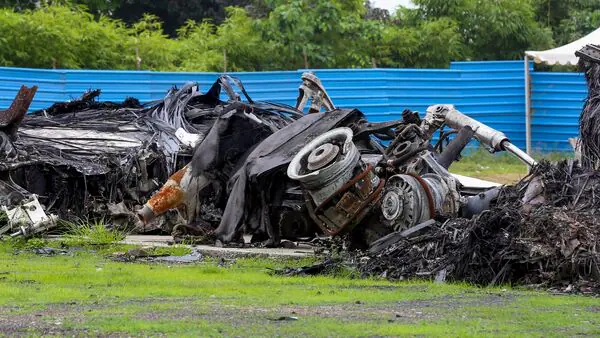DGCA Orders Mandatory Fuel Switch Lock Inspections on All Boeing Jets Amid Crash Probe
- MGMMTeam

- Jul 14
- 4 min read
New Delhi Tightens Aviation Safety After AI171 Tragedy
In the wake of a devastating air disaster involving Air India Flight AI171, the Directorate General of Civil Aviation (DGCA) has taken decisive action by mandating inspections of fuel switch locking mechanisms on all Boeing aircraft operated by Indian carriers. The directive, issued on July 14, 2025, requires airlines to complete thorough inspections by July 21, aiming to prevent any recurrence of similar mechanical anomalies that may have contributed to the fatal crash.

Trigger: The AI171 Crash and Its Startling Findings
The directive follows the preliminary findings of the Aircraft Accident Investigation Bureau (AAIB), which revealed a critical issue involving the fuel control switches on the ill-fated Boeing 787 Dreamliner. The aircraft, which had departed from Ahmedabad on June 12, tragically plummeted just seconds after takeoff, resulting in the loss of 260 lives—including 242 passengers and crew members and 18 people on the ground.
According to the initial AAIB investigation, both engine fuel switches unexpectedly moved from the "RUN" position to "CUTOFF" mid-air, causing a complete loss of power. Although the cockpit crew attempted to reactivate the switches, it was too late. The aircraft crashed into a nearby medical college hostel, turning the flight into one of the most catastrophic aviation disasters in India’s recent history.
A Forgotten Warning: The 2018 FAA Advisory
One of the most concerning revelations is the connection to a 2018 advisory issued by the United States Federal Aviation Administration (FAA). The advisory, published as a Special Airworthiness Information Bulletin (SAIB NM-18-33), had flagged potential safety concerns regarding the fuel control switch lock design in several Boeing models, including the 787 Dreamliner. The FAA had warned that, in some cases, the locking mechanisms were either missing or installed incorrectly, allowing unintentional movement of the switches.
Although the bulletin was non-binding, it was intended to alert global operators to a possible hazard. Air India, like many other carriers, did not implement corrective actions based on the advisory, citing its advisory nature and lack of mandatory enforcement. This omission is now under scrutiny, especially given that the very issue highlighted in 2018 may have played a role in the June 2025 disaster.
DGCA’s Preventive Action and Scope of the Directive
The DGCA has now acted firmly, ordering all Indian airlines operating Boeing aircraft to inspect and verify the integrity of fuel switch locking systems. The directive covers Boeing 787 Dreamliners, as well as select 737 and other variants, operated by carriers such as Air India, Vistara, SpiceJet, and IndiGo.
Airlines are required to conduct a physical inspection of each aircraft's fuel switch lock assembly and submit compliance reports to DGCA’s regional offices by July 21. This move, though swift, is seen as necessary to restore public trust in civil aviation safety, especially at a time when mechanical failure is suspected to have caused the deaths of hundreds.
Global Ripples and Boeing’s Response
The impact of the AI171 crash has extended beyond Indian borders. Several international airlines, including Singapore Airlines, Etihad Airways, and Japan Airlines, have reportedly initiated their own internal checks on Boeing aircraft, even in the absence of a formal global directive.
Meanwhile, both the FAA and Boeing have maintained that the locking systems currently in use meet all safety standards and do not pose a significant risk. They have clarified that the SAIB issued in 2018 was a precautionary document and not a response to any systemic defect. Nevertheless, the AI171 case has prompted renewed debate over how seriously airlines should treat non-mandatory advisories when potential safety risks are involved.
Inspections, Replacements, and Unanswered Questions
Air India has since revealed that the fuel switch module on the crashed aircraft had been replaced twice—once in 2019 and again in 2023—as part of routine maintenance. However, the investigation continues to explore whether the switches failed mechanically, were moved accidentally by crew, or suffered from a deeper systemic issue.
The cockpit voice recorder has added another layer of complexity to the probe. Transcripts show no verbal commands from the pilots to move the switches, nor any indication that they were aware of such movement until both engines had already failed. This has raised the possibility of inadvertent contact or a design flaw, a matter the AAIB is continuing to investigate.
Conclusion: A Call for Proactive Oversight
The DGCA’s directive reflects a proactive approach to aviation safety, ensuring that no assumption is left unexamined when lives are at stake. While the crash of AI171 has sparked outrage and grief, it has also served as a sobering reminder of the need for vigilance, even when advisories are merely suggestive and not compulsory.
In the coming weeks, the aviation community will be closely watching the final conclusions of the AAIB’s investigation. Until then, Indian authorities are taking no chances, and rightly so. As the skies grow more crowded and aircraft more complex, safety must remain an uncompromising priority—not only in regulation but also in implementation.
(Sources: IndiaTV News, Mint, NDTV)




Comments